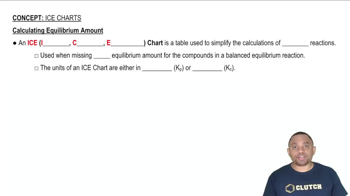Here are the essential concepts you must grasp in order to answer the question correctly.
Chemical Equilibrium
Chemical equilibrium occurs when the rates of the forward and reverse reactions are equal, resulting in constant concentrations of reactants and products. In this state, the system is dynamic, meaning that reactions continue to occur, but there is no net change in concentration. Understanding this concept is crucial for analyzing how concentrations change in response to initial conditions and how they relate to the equilibrium constant.
Recommended video:
Chemical Equilibrium Concepts
Equilibrium Constant (Kc)
The equilibrium constant (Kc) is a numerical value that expresses the ratio of the concentrations of products to reactants at equilibrium, each raised to the power of their coefficients in the balanced equation. For the reaction H2(g) + I2(g) ⇌ 2 HI(g), Kc = [HI]^2 / ([H2][I2]). This constant provides insight into the extent of the reaction and is essential for calculating equilibrium concentrations from initial amounts.
Recommended video:
Equilibrium Constant Expressions
ICE Table (Initial, Change, Equilibrium)
An ICE table is a tool used to organize the initial concentrations, the changes in concentrations as the reaction proceeds, and the equilibrium concentrations of reactants and products. By setting up an ICE table for the given reaction, one can systematically determine how the concentrations of H2, I2, and HI change from their initial values to equilibrium, facilitating the calculation of unknown concentrations using the equilibrium constant.
Recommended video:
ICE Charts and Equilibrium Amount




